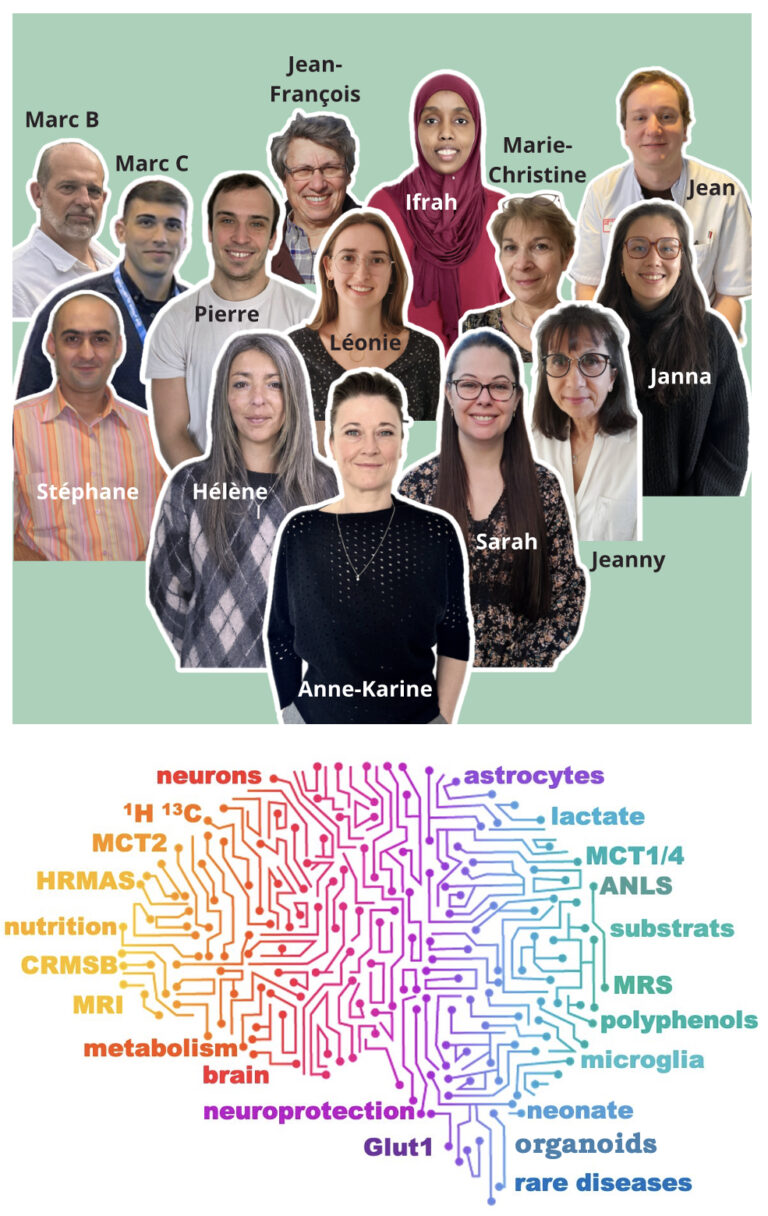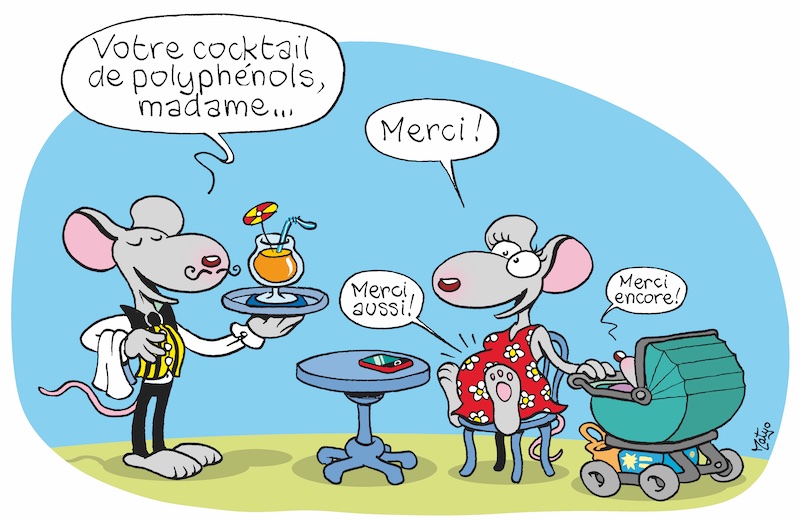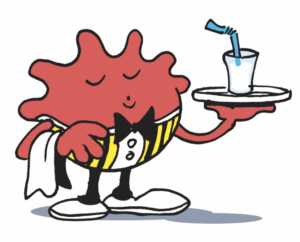Métabolisme cérébral
Axe de recherche dirigé par Anne-Karine BOUZIER-SORE

MEMBERS
- Dr Anne-Karine Bouzier-Sore (DR CNRS)
- Dr Hélène Roumes (CR CNRS)
- Dr Sarah Courtois (MCU)
- Pr Jean-François Chateil (PU-PH)
- Dr Marie-Christine Beauvieux (MCU-PH)
- Dr Jean Delmas (PH)
- Dr Marc Biran (IR CNRS)
- Dr Jeanny Laroche-Traineau (IR CNRS)
- Karine Viaud (IE CNRS)
- Stéphane Sanchez (Zootechnicien CNRS)
- Ifrah Omar (Post-doc)
- Pierre Goudeneche (PhD)
- Marc Chillida (PhD)
- Léonie Dayraut (PhD)
🧠 Neuroenergetics — how the brain generates energy to sustain its functions — is gaining growing interest, from enhancing cognitive performance through lifestyle factors like exercise and nutrition, to developing neuroprotective strategies against neurodegenerative diseases. Understanding the cellular mechanisms linking neuronal activity and energy homeostasis is key to uncovering how neurons meet their high energy demands.
🔬 Our team has long investigated the Astrocyte-Neuron Lactate Shuttle Hypothesis (ANLSH, Pellerin and Magistretti, PNAS 1994). Using NMR spectroscopy and, more recently, in vivo functional MRI and MRS in genetically modified rats, we are studying whether lactate transfer occurs in the living brain and its importance for neuronal function (Roumes et al. PNAS 2021).
💡 This raises a central question: if lactate is a good neuronal fuel, could it also be neuroprotective?
🐀 Building on our discoveries, we are exploring therapeutic strategies for neonatal hypoxia-ischemia—a leading cause of infant mortality and disability, with no current pharmacological treatment. We showed that lactate administration is neuroprotective (Roumes et al., JCBFM 2021).
🍇 We also study how nutrition affects brain metabolism. We’ve demonstrated that polyphenols, beyond their anti-inflammatory and antioxidant effects, modulate energy metabolism and enhance the expression of genes and proteins involved in the ANLS (Dumont et al., Front in Neurosci 2020).
👶 Our main focus is on neuroenergetics in neonates, which differs from adults and remains poorly understood. We aim to apply our knowledge to develop novel treatments for rare pediatric diseases such as hypoxia-ischemia in neonate (ORPHA:137577) or Glut1 deficiency (ORPHA:71277).
🧫 We recently welcomed a new researcher, Sarah, who will lead a project on pediatric rare metabolic disorders. She will develop brain organoids from patient-derived fibroblasts, providing a powerful model to investigate energy metabolism in these conditions.
G. Plourde et al., Neuroprotective effects of lactate and ketone bodies in acute brain injury. J Cereb Blood Flow Metab, 271678X241245486; Apr 11, 2024.
I. Fernández-Moncada et al., A lactate-dependent shift of glycolysis mediates synaptic and cognitive processes. Nature Communications vol.15, p1-17, 2024.
H. Roumes et al., Astrocytes as metabolic suppliers to support neuronal activity and brain functions. Essays Biochem 67, 27; Mar 3, 2023.
H. Roumes et al., Neuroprotective Effect of Eco-Sustainably Extracted Grape Polyphenols in Neonatal Hypoxia-Ischemia. Nutrients 14, Feb 12, 2022.
H. Roumes et al., Resveratrol and Some of Its Derivatives as Promising Prophylactic Treatments for Neonatal Hypoxia-Ischemia. Nutrients 14, Sep 14, 2022.
H. Roumes et al., Lactate transporters in the rat barrel cortex sustain whisker-dependent BOLD fMRI signal and behavioral performance. Proc Natl Acad Sci U S A 118, Nov 23, 2021.
H. Roumes et al., Neuroprotective role of lactate in rat neonatal hypoxia-ischemia. J Cereb Blood Flow Metab 41, 342; Feb, 2021.
C. Lucas-Torres et al., Metabolic NMR mapping with microgram tissue biopsy. NMR Biomed 34, e4477; Apr, 2021.
D. Loncaric et al., alpha-Tocopherol Acetate Attenuates Mitochondrial Oxygen Consumption and Maintains Primitive Cells within Mesenchymal Stromal Cell Population. Stem Cell Rev Rep 17, 1390; Aug, 2021.
D. Lagarde et al., Lactate fluxes mediated by the monocarboxylate transporter-1 are key determinants of the metabolic activity of beige adipocytes. J Biol Chem, Dec 2, 2021.
U. Dumont et al., Neuroprotective Effect of Maternal Resveratrol Supplementation in a Rat Model of Neonatal Hypoxia-Ischemia. Front Neurosci 14, 616824; 2021.
H. Roumes et al., [Neuroprotective role of lactate in neonatal hypoxia-ischemia]. Med Sci (Paris) 36, 973; Nov, 2020.
C. Lucas-Torres et al., General Guidelines for Sample Preparation Strategies in HR-microMAS NMR-based Metabolomics of Microscopic Specimens. Metabolites 10, Jan 30, 2020.
D. Jimenez-Blasco et al., Glucose metabolism links astroglial mitochondria to cannabinoid effects. Nature 583, 603; Jul, 2020.
U. Dumont et al., Maternal alcoholism and neonatal hypoxia-ischemia: Neuroprotection by stilbenoid polyphenols. Brain Res 1738, 146798; Jul 1, 2020.
C. Jolle et al., Development of Efficient AAV2/DJ-Based Viral Vectors to Selectively Downregulate the Expression of Neuronal or Astrocytic Target Proteins in the Rat Central Nervous System. Front Mol Neurosci 12, 201; 2019.
M. Hosseini et al., UVB-induced DHODH upregulation, which is driven by STAT3, is a promising target for chemoprevention and combination therapy of photocarcinogenesis. Oncogenesis 8, 52; Sep 24, 2019.
U. Dumont et al., Maternal consumption of piceatannol: A nutritional neuroprotective strategy against hypoxia-ischemia in rat neonates. Brain Res 1717, 86; Aug 15, 2019.
Y. Cremillieux et al., Online Quantification of Lactate Concentration in Microdialysate During Cerebral Activation Using (1)H-MRS and Sensitive NMR Microcoil. Front Cell Neurosci 13, 89; 2019.
J. Blanc et al., Functional Magnetic Resonance Spectroscopy at 7 T in the Rat Barrel Cortex During Whisker Activation. J Vis Exp, Feb 8, 2019.
N. Marissal-Arvy et al., Insulin treatment partially prevents cognitive and hippocampal alterations as well as glucocorticoid dysregulation in early-onset insulin-deficient diabetic rats. Psychoneuroendocrinology93, 72; Jul, 2018.
M. Hosseini et al., Energy Metabolism Rewiring Precedes UVB-Induced Primary Skin Tumor Formation. Cell Rep 23, 3621; Jun 19, 2018.
D. El Hamrani et al., Consumption of Alcopops During Brain Maturation Period: Higher Impact of Fructose Than Ethanol on Brain Metabolism. Front Nutr 5, 33; 2018.
L. F. Barros et al., Current technical approaches to brain energy metabolism. Glia 66, 1138; Jun, 2018.
L. Mazuel et al., A neuronal MCT2 knockdown in the rat somatosensory cortex reduces both the NMR lactate signal and the BOLD response during whisker stimulation. PLoS One 12, e0174990; 2017.
N. T. Duong et al., Evaluation of a high-resolution micro-sized magic angle spinning (HRμMAS) probe for NMR-based metabolomic studies of nanoliter samples. Anal. Methods 8, 6815; 2016.
M. Roy et al., Rapid adaptation of rat brain and liver metabolism to a ketogenic diet: an integrated study using H- and C-NMR spectroscopy. J Cereb Blood Flow Metab 35, 1154; Mar 18, 2015.
Y. Nishiyama et al., High-resolution NMR-based metabolic detection of microgram biopsies using a 1 mm HRmuMAS probe. Analyst, Nov 13, 2015.
M. Hennebelle et al., Energy restriction does not prevent insulin resistance but does prevent liver steatosis in aging rats on a Western-style diet. Nutrition 31, 523; Mar, 2015.
A. K. Bouzier-Sore et al., Uncertainties in pentose-phosphate pathway flux assessment underestimate its contribution to neuronal glucose consumption: relevance for neurodegeneration and aging. Front Aging Neurosci 7, 89; 2015.
M. C. Beauvieux et al., High-fructose diet enhances cerebral neurodegenerative process; preventive effect of resveratrol. A nuclear magnetic resonance imaging and spectroscopy study on rat nutritional models. Nutrition and aging 2, 15; 2014.
D. Sampol et al., Glucose and lactate metabolism in the awake and stimulated rat: a (13)C-NMR study. Front Neuroenergetics 5, 5; 2013.
M. Roy et al., Long-term calorie restriction has minimal impact on brain metabolite and fatty acid profiles in aged rats on a Western-style diet. Neurochem Int 63, 450; Nov, 2013.
T. B. Rodrigues et al., 13C NMR spectroscopy applications to brain energy metabolism. Front Neuroenergetics 5, 2013.
A. K. Bouzier-Sore et al., Unraveling the complex metabolic nature of astrocytes. Front Cell Neurosci 7, 179; 2013.
C. Lalande et al., Magnetic resonance imaging tracking of human adipose derived stromal cells within three-dimensional scaffolds for bone tissue engineering. Eur Cell Mater 21, 341; 2011.
M.-J. Jacobin-Valat et al., Magnetic resonance imaging if inducible P-selectin expression in human activated platelets. NMR in Biomed on line, 2011.
P. Voisin et al., Microglia in close vicinity of glioma cells: correlation between phenotype and metabolic alterations. Front Neuroenergetics 2, 131; 2010.
O. Brissaud et al., Short-term effect of erythropoietin on brain lesions and aquaporin-4 expression in a hypoxic-ischemic neonatal rat model assessed by magnetic resonance diffusion weighted imaging and immunohistochemistry. Pediatr Res 68, 123; Aug, 2010.
A. K. Bouzier-Sore et al., Nanoparticle phagocytosis and cellular stress: involvement in cellular imaging and in gene therapy against glioma. NMR Biomed 23, 88; Sep 30, 2010.
E. J. Ribot et al., Study of the MR relaxation of microglia cells labeled with Gd-DTPA-bearing nanoparticles. Contrast Media Mol Imaging 4, 109; May, 2009.
P. Voisin et al., Use of lanthanide-grafted inorganic nanoparticles as effective contrast agents for cellular uptake imaging. Bioconjug Chem 18, 1053; Jul-Aug, 2007.
E. Ribot et al., Microglia used as vehicles for both inducible thymidine kinase gene therapy and MRI contrast agents for glioma therapy. Cancer Gene Ther 14, 724; Aug, 2007.
L. Pellerin et al., Activity-dependent regulation of energy metabolism by astrocytes: an update. Glia 55, 1251; Sep, 2007.
A. K. Bouzier-Sore et al., Competition between glucose and lactate as oxidative energy substrates in both neurons and astrocytes: a comparative NMR study. Eur J Neurosci 24, 1687; Sep, 2006.
A. K. Bouzier-Sore et al., Lactate is a preferential oxidative energy substrate over glucose for neurons in culture. J Cereb Blood Flow Metab 23, 1298; Nov, 2003.
A. K. Bouzier-Sore et al., Lactate involvement in neuron-glia metabolic interaction: (13)C-NMR spectroscopy contribution. Biochimie 85, 841; Sep, 2003.
M. Merle et al., Time-dependence of the contribution of pyruvate carboxylase versus pyruvate dehydrogenase to rat brain glutamine labelling from [1-(13) C]glucose metabolism. J Neurochem 82, 47; Jul, 2002.
A. K. Bouzier-Sore et al., Feeding active neurons: (re)emergence of a nursing role for astrocytes. J Physiol Paris 96, 273; Apr-Jun, 2002.
A. K. Bouzier-Sore et al., Effect of exogenous lactate on rat glioma metabolism. J Neurosci Res 65, 543; Sep 15, 2001.
A. K. Bouzier et al., The metabolism of [3-(13)C]lactate in the rat brain is specific of a pyruvate carboxylase-deprived compartment. J Neurochem 75, 480; Aug, 2000.
A. K. Bouzier et al., [1-(13)C]glucose metabolism in the tumoral and nontumoral cerebral tissue of a glioma-bearing rat. J Neurochem 72, 2445; Jun, 1999.
A. K. Bouzier et al., Glucose and lactate metabolism in C6 glioma cells: evidence for the preferential utilization of lactate for cell oxidative metabolism. Dev Neurosci 20, 331; 1998.
A. K. Bouzier et al., Compartmentation of lactate and glucose metabolism in C6 glioma cells. A 13c and 1H NMR study. J Biol Chem 273, 27162; Oct 16, 1998.
B. Quesson et al., Magnetization transfer fast imaging of implanted glioma in the rat brain at 4.7 T: interpretation using a binary spin-bath model. J Magn Reson Imaging 7, 1076; Nov-Dec, 1997.
Une maman bien nourrie, un enfant qui sourit
« Naissance, mise au monde,
Rencontre de l’enfant et de sa mère,
Moment émouvant mais éphémère,
Quand les problèmes grondent.
Complication,
Manque d’oxygène,
Réanimation,
Fléau pathogène.
L’hypoxie-ischémie a sévi
Endommageant le cerveau du bambin à vie.
Seule possibilité : le refroidissement
Mais cela est insuffisant.
Détresse,
Tristesse.
Il faut de nouvelles solutions,
Pour offrir à ces bébés une neuroprotection.
Une idée, une solution !
La nutrition comme neuroprotection ?
Mieux manger pour mieux vivre
Ou mieux manger pour survivre.
Les plantes pour se défendre,
Produisent des molécules de grandes vertus.
Ces polyphénols ont été testés sans attendre,
Pour que plus jamais l’hypoxie-ischémie ne tue.
Les mères ont été supplémentées,
Avec des polyphénols dans leur eau de boisson.
Le pire a été évité :
Plus de lésion chez les nourrissons.
L’équivalent d’un fruit de la passion
Voilà une faible ration
Pour ôter aux mères leur chagrin
Et sauver tous ces chérubins. »
Hélène Roumes




